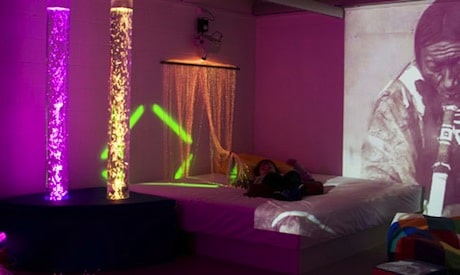
Imagine being in an environment where everything has been placed and designed to tantalize your senses. You can hear delightful music, smell wonderful fragrances, feel soft textures, and taste your favorite foods. Are you doing a guided visualization? Are you hallucinating? No, you are in a Snoezelen therapy room.
What is Snoezelen Therapy?
Snoezelen therapy involves use of an environment, typically a room that has been equipped with items that invite participants to engage their senses at their own pace. The goal is to both stimulate the senses by invoking memories and interest while also have a relaxing, calming effect on the individuals that allows them to feel safe and comfortable. According to the International Snoezelen Association, the approach “induces wellbeing” and provides a “calm atmosphere” where “fear will be taken away.”
The word “snoezelen” comes from “snuffeln” (to sniff) and “doezelen” (to snooze). Snoezelen was developed in the 1970s in the Netherlands as a way to care for severely disabled people living in institutions. Today Snoezelen is used for the same original purpose and also for individuals living in nursing facilities (especially those with Alzheimer’s disease or other forms of dementia) and for children and others with autism or behavioral disorders.
Read more about natural ways to treat Alzheimer’s Disease
Proponents of Snoezelen therapy are not stopping there; they are exploring the use of this healing approach for individuals with brain injury, cerebral palsy, communications disorders, muscular dystrophy, spina bifida, and children with various disabilities.
Snoezelen At Work
Currently, there are approximately 1,200 Snoezelen rooms in North America, according to the company (FlagHouse) providing equipment for the rooms, such as special fiber optic bubble tubes, revolving lights, soft swings and rockers, projection equipment, soft artwork, and aromatherapy. However, facilities and individuals can create their own Snoezelen rooms without investing in expensive equipment if they work with a mental health professional to choose the best items for the room.
An example of a Snoezelen room that is helping children and adults with autism is located in St. Petersburg, Florida, at PARC, a nonprofit that serves individuals with developmental challenges. In a recent article in the Tampa Bay Times, occupational therapist Linda Messbauer, who established the first Snoezelen in the United States more than two decades ago, noted that this sensory therapeutic approach helps children with autism relax.
Read more about preventing autism
“You’re putting the brain on vacation. You’re taking it out of the stress and the sensory processing issues that (children with autism) have.”
In Mitchell, Ontario, Canada, the Ritz Lutheran Villa has a Snoezelen room for residents with dementia. The room sports a giant lighted bubble tube that is surrounded by mirrors, shades where pastel designs can be projected, a box containing various materials that are pleasing to the touch, and a fiber optic light spray that invites people to touch it.
According to RPN Liz Garant, the goal of the room is to “get them [residents] here before the behaviors start.” The behaviors to which she refers are agitation and aggression, which appear among some people with dementias. Use of Snoezelen rooms can help reduce the need for antianxiety medications.
If you have an autistic child, a parent or spouse with dementia, or a family member with developmental challenges and you want to know more about how exposure to a Snoezelen room may help, talk to your healthcare provider, assisted living or similar facilities in your area, or an occupational therapist. You also can get more information about Snoezelen rooms at this website.
Photo Credit: akvacare




